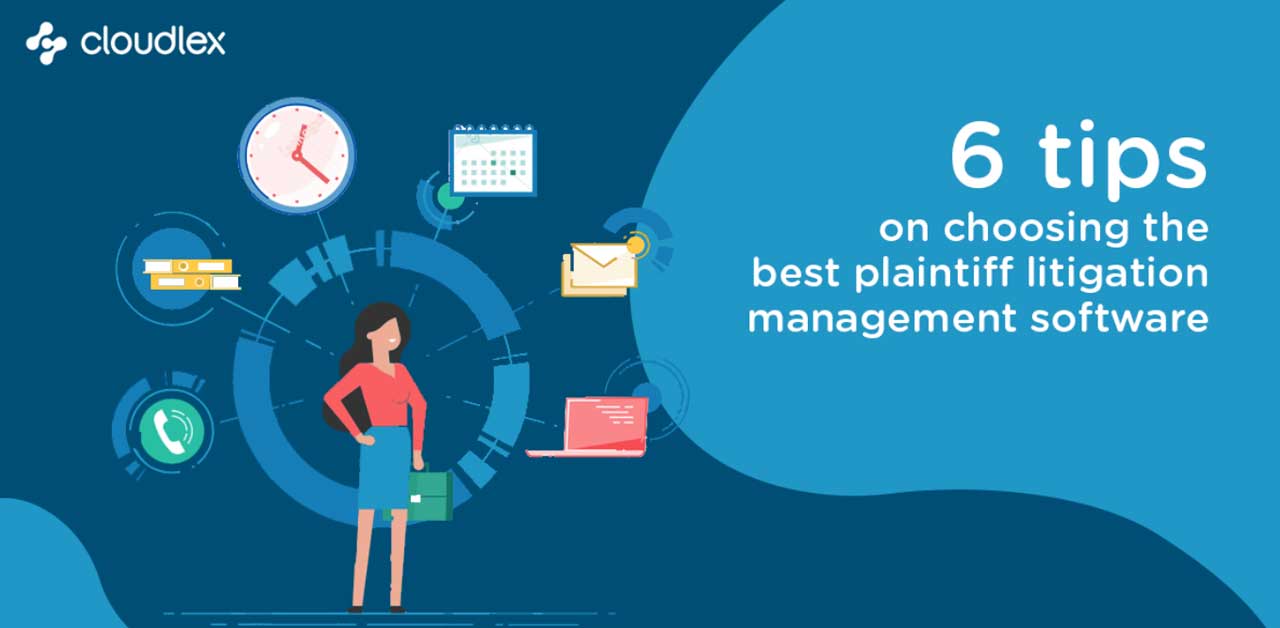All plaintiff law firms use some version of a litigation matter tracking software—from the crude (messy piles on a partner’s desk) to the sophisticated (documents in the palm of your hand).
Litigation management software is the logistics of the law firm; it helps to manage and track every stage of litigation from client intake software to discovery, trial to settlement. It allows you to record intake, track events, manage documents, tasks and reports all in one place so your firm can process cases efficiently, saving time and money.
There are essentially three types of litigation software:
- 1. On-premise. “On-premises” litigation software requires you to run an internal “mini-datacenter” involving servers, operating systems, databases, IT support, installation, hosting, networking and all the pain and suffering of managing this yourself. Simply put, you’ll have to invest in and implement the entire infrastructure in your office.
- 2. Hybrid Technology. Hybrid case management systems are just that – hybrids. They are legacy systems repackaged as hosted solutions. Only now you have the added frustration of accessing ancient technology through slow VPN and remote desktop connections.
- 3. Cloud-based. Cloud-based allows you to access your data anywhere, anytime and on any internet capable device. You can access a critical document while on the run. Cloud-based software are available on monthly or yearly subscription, which are not just cash-flow friendly, but 70% less than the cost of on-premise software.
The Cloud is the latest in modern technology that businesses across industries are relying on. Still, “the cloud” can be a scary and confusing place for some. To help “uncloud” the mystery surrounding it, here are 6 ways you can determine which is the best personal legal case management system for your personal injury firm’s needs.
1. It should be built using modern technology
One of the biggest challenges/shortcomings of legacy systems is that by virtue of being designed in the ’90s, they have a rather monolithic architecture that makes them more vulnerable to malicious code written today. So, how big is the generation gap between the two technologies? Well, the short answer is, the same as that between Pac-Man Arcade and Fortnite Season 11!
A true cloud platform is built on the latest, most-sophisticated web technologies, from the ground-up. Meaning the application is conceived, conceptualized, designed, and developed as a cloud application, right from the start. The “cloud” cannot be retro-fitted to legacy hosted solutions developed decades ago.
Moreover, cloud-based systems are infrastructure-light and user-friendly. They work with you, not against you. They can be scaled up, or down, depending on your firm’s needs and capabilities, without sacrificing security or technology. A cloud system is robust and flexible and can be accessed anytime, anywhere, and on any device. Simply put, cloud technology is behind most of your applications, think of your favorite social network, streaming service, email provider…. that ‘s right, you’ve been using cloud technology all along, you just didn’t know it.
2. It should fit your litigation needs
Whether it’s ordering a burrito or a nice suit, a one-size fits all mentality is a thing of the past—so why shouldn’t your plaintiff litigation management software be as flexible as your Chipotle?
Firms’ needs vary based on a variety of factors such as size, practice area, and budgetary constraints, and your personal injury case management software should be able to adapt to those needs and, ultimately, the needs of your clients.
Legal software should not be one-size fits all; on the contrary, it should be specifically tailored for personal injury practices. It should understand the needs of trial lawyers.
If software forces you to change your existing business processes in order to use it, consider it a red flag. For example, there are generic case management software with time tracking features available, but personal injury lawyers don’t bill on an hourly basis, so using that software will slow down your growth and won’t allow you to scale in the long run.
The best case management software is the one which is built for your personal injury practice, with your business processes in mind.
3. It should allow you to work remotely
Life today is increasingly mobile: you can make a call on your TV and watch a show on your phone. We live in a world where everything we need is available at our fingertips, at any time, and your case management software should be no different. If you’ve ever streamed a movie on your TV, you’re already living in the cloud.
Using a cloud-based legal case management software is like streaming movies on Netflix, while firms still using a legacy based system are busy running to Blockbuster.
Your litigation software should allow employees to access case information efficiently, whenever and wherever they need it. It should allow them to work remotely from wherever they are.
That’s because the cloud based software is connected 24/7/365 and is compatible with any internet-capable device (Windows, Android or iOS)—making your firm agile and better suited to meet the needs of your clients and staff alike.
4. It should be easy to maintain
In the past, purchasing personal injury software was similar to purchasing a printer; even if you got a good deal on the printer (“the software”), you were constantly running to the store to buy overpriced ink (“the software upgrades”).
And the worst part is, you couldn’t even install the ink yourself; old-school personal injury software systems require constant on-site IT support. Translation: continual and unpredictable costs that leave your business in the red ink instead of the black.
With cloud-based personal injury software, you’re getting a printer with a never-ending supply of ink, because all technology upgrades are included in the cost. And the best part is, you don’t have to wait for Doug the IT intern to install them because upgrades occur magically in your sleep. All you have to do is wake up, and get to work.
And since your system does not reside on-site, no on-site maintenance is required. Instead, everything is handled from the cloud. Cloud-based personal injury case management software are proactive. Before any updates are installed, they’ve been tested more times than a PhD student—so they work seamlessly.
And the systems are constantly monitored to identify and fix issues well before they become a problem (Wouldn’t it be nice if a doctor could make your cold go away before your first sneeze?). In other words, cloud-based personal injury systems lead to decreased costs, and increased efficiency, resulting in a better bottom-line for your firm.
5. You shouldn’t require engineers to operate
There are many routine logistical tasks that are essential to running a successful law firm, from maintaining the calendar to data entry to reporting.
The role of a successful case management software is to keep these tasks successfully running in the background, so a firm can focus its energy on being successful advocates for its clients.
Litigation software should be both intuitive and easy-to-use for everyone—from attorneys down to the intern that messed up your coffee order. As a result, these tasks become second-hand and automated, allowing your firm to take on more work without taking on more staff.
6. It should be cost-effective
An obvious tenet of any successful law firm is to keep costs down while refusing to sacrifice quality. When choosing a case management software, this strategy should be no different.
Implicit in all the factors above is that cloud-based solutions are not only the most cost-effective, but they also are the most flexible and efficient.
Cloud-based manager management software doesn’t require extra overheads in the form of extra space, equipment, or staff. And there are no long-term fees for maintenance and support.
Instead, you get a secure and HIPAA compliant system hosted by tech giants like Amazon and Microsoft meaning no unforeseen headaches or expenses in the future. It’s like getting the best house on the block with little down payment, tiny mortgage payments, and zero chance of foreclosure.
If you’re ready to learn more about cloud-based legal technologies and get a leg up on your competitors, visit our website. Or better yet, if you want to see exactly how CloudLex can streamline your personal injury litigation practice into a well-oiled, paperless machine, you can schedule a demo now. It’s like borrowing your friend’s Netflix password, while your competitors are too busy building a VCR room. We look forward to working with you and expanding your practice exponentially.
Also Read: Get Your Head into the Cloud: Determining the Best Case Management Software for Your Firm

